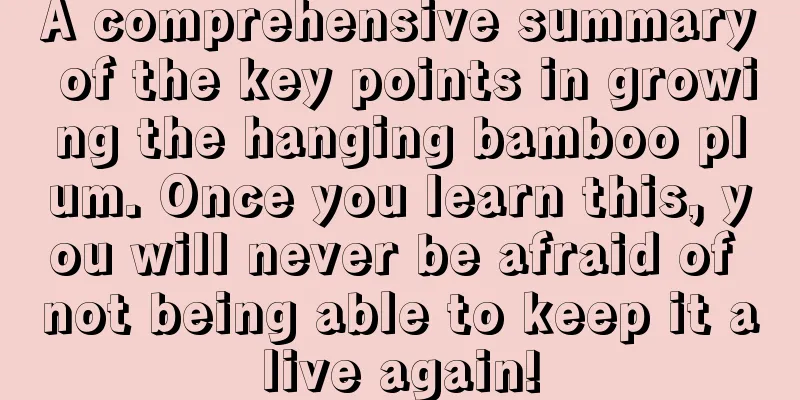A comprehensive summary of the key points in growing the hanging bamboo plum. Once you learn this, you will never be afraid of not being able to keep it alive again!

1. Maintenance methods1. Temperature: Hanging bamboo plum likes warmth. Specifically, as long as the temperature is above fourteen degrees, it can grow normally. In winter, it needs to be protected from the cold and the temperature should not drop below eight degrees. This is safer and can allow it to spend the winter safely. In summer, the temperature should not be too high, otherwise its leaves will dry out. 2. Watering: Hanging bamboo plum likes moisture. It is not drought-tolerant but has better waterlogging tolerance. Therefore, during the growth period, it is necessary to water it sufficiently and keep the soil in the pot moist at all times. If it is too dry, its leaves will wilt. In winter, you cannot completely stop watering the plant. Keep the soil in the pot slightly moist. 3. Light: The plant is afraid of strong light, but it cannot be completely without light. Therefore, it can be placed in a semi-shaded position. When encountering strong light in the summer, you need to provide shade in time, or place it directly in a cool, ventilated place. 4. Flower soil: The pH requirement is not too high. The main requirements are nutrition and breathability. Sandy loam can be used. 2. Breeding techniques1. Repotting: Because the plant has high requirements for the air permeability of the flower soil, and the flower soil tends to clump after a period of time, it is very important to repot regularly. Generally speaking, it should be replaced every two or three years, and the interval does not need to be too short. You can loosen the soil frequently and change the pot when the clumping is very serious. When repotting, you can also prune the root system. 2. Reproduction: The main method used is cutting. March to May is better. Choose strong branches as cuttings and cut them to seven to ten centimeters. Cut off some of the lower leaves. Prepare good quality substrate and then take cuttings. Ensure the temperature is between 18 and 25 degrees. 3. Problem diagnosis and treatment1. Disease: The main disease is "gray mold", which is more likely to occur at high temperatures. It can be cured by using medication in time. Generally, two applications of medication can cure it. At the same time, ventilation needs to be improved. 2. Pests: Compared with diseases, pests are less common, but they still occur sometimes. For example, aphids and other insects will appear, and they need to be eliminated in time before their numbers increase. IV. Other issues1. Toxicity: It is non-toxic. Both the substance itself and the gas it emits are non-toxic. 2. Can it be kept at home: It can be kept at home. In fact, it is a small potted plant that can be grown at home. Moreover, it is very ornamental and suitable to be placed at home. |
<<: How to grow the gypsophila macrophylla to make it flourish? Is it the same as lucky bamboo?
>>: Where can't lucky bamboo be placed? Can it be placed on the air conditioner?
Recommend
Cultivation methods and precautions of Cuihuangguan
1. Water When growing the green crown lily, good ...
Key points for rose maintenance
1. Lighting requirements Roses like to grow in pl...
Can Sweetheart Blueberry be grown in the South?
Can sweetheart blueberries be grown in the south?...
How often should I water my spider plant?
Daily watering There is no need to pursue the sta...
How to prune blue snow flower (pruning time and method)
When to prune blue snowflakes The best time to pr...
Cultivation techniques and precautions for Christmas cactus
Christmas cactus has become a leader among indoor...
Can peanut seedlings be transplanted?
Can peanut seedlings be transplanted? Peanut seed...
Difference between allspice and pimento
1. Difference of blades The leaves of allspice ar...
How to grow Kalanchoe? Is it poisonous to grow it indoors?
1. Breeding methods 1. Temperature: The most suit...
If you do a little more when watering, the flowers will grow wildly and the leaves will be green as hell!
Throw expired vitamin C into water, the leaves ar...
Cherry cultivation method
1. Seed Planting 1. Time: Cherries should be plan...
How often should I water the caltrop?
How often should I water the caltrop? Water the o...
How to plant potted mulberries
Planting time It is generally planted in winter a...
How to breed the star beauty and what to pay attention to
Reproduction method of the star beauty The main m...
Cultivation method of osmanthus tree
Osmanthus fragrans, an evergreen shrub , is famou...









